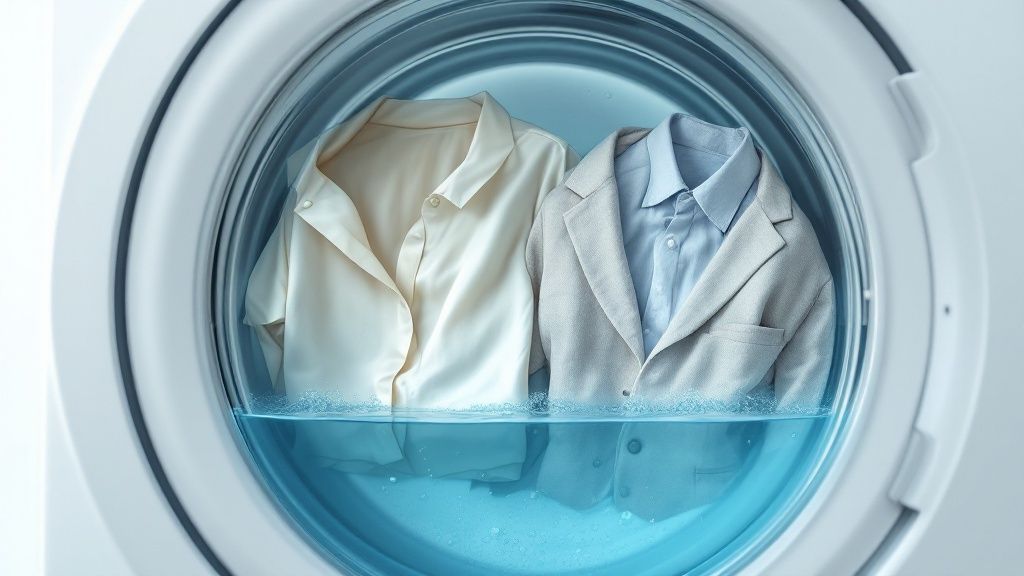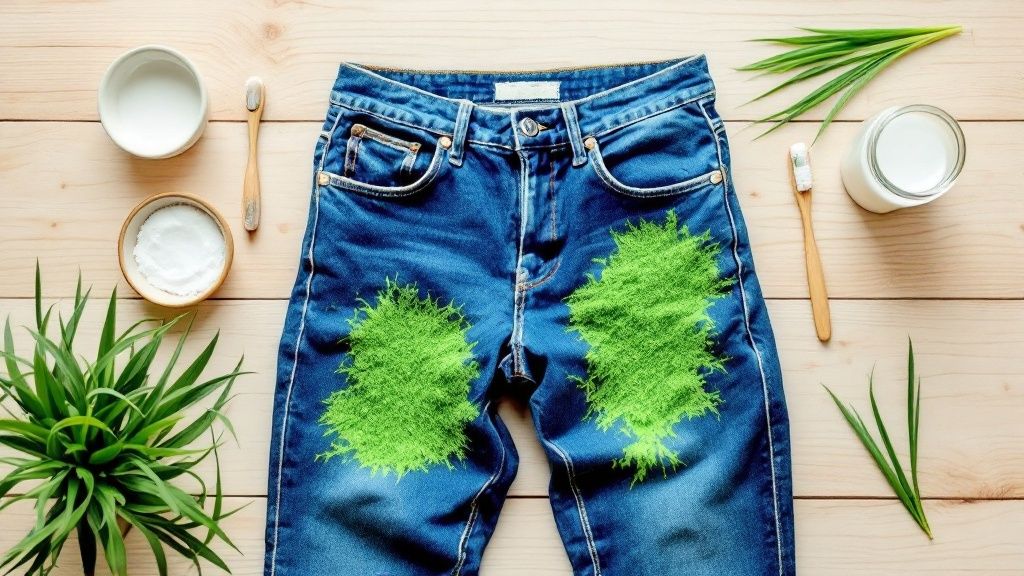How to Keep Clothes from Shrinking The Ultimate Guide
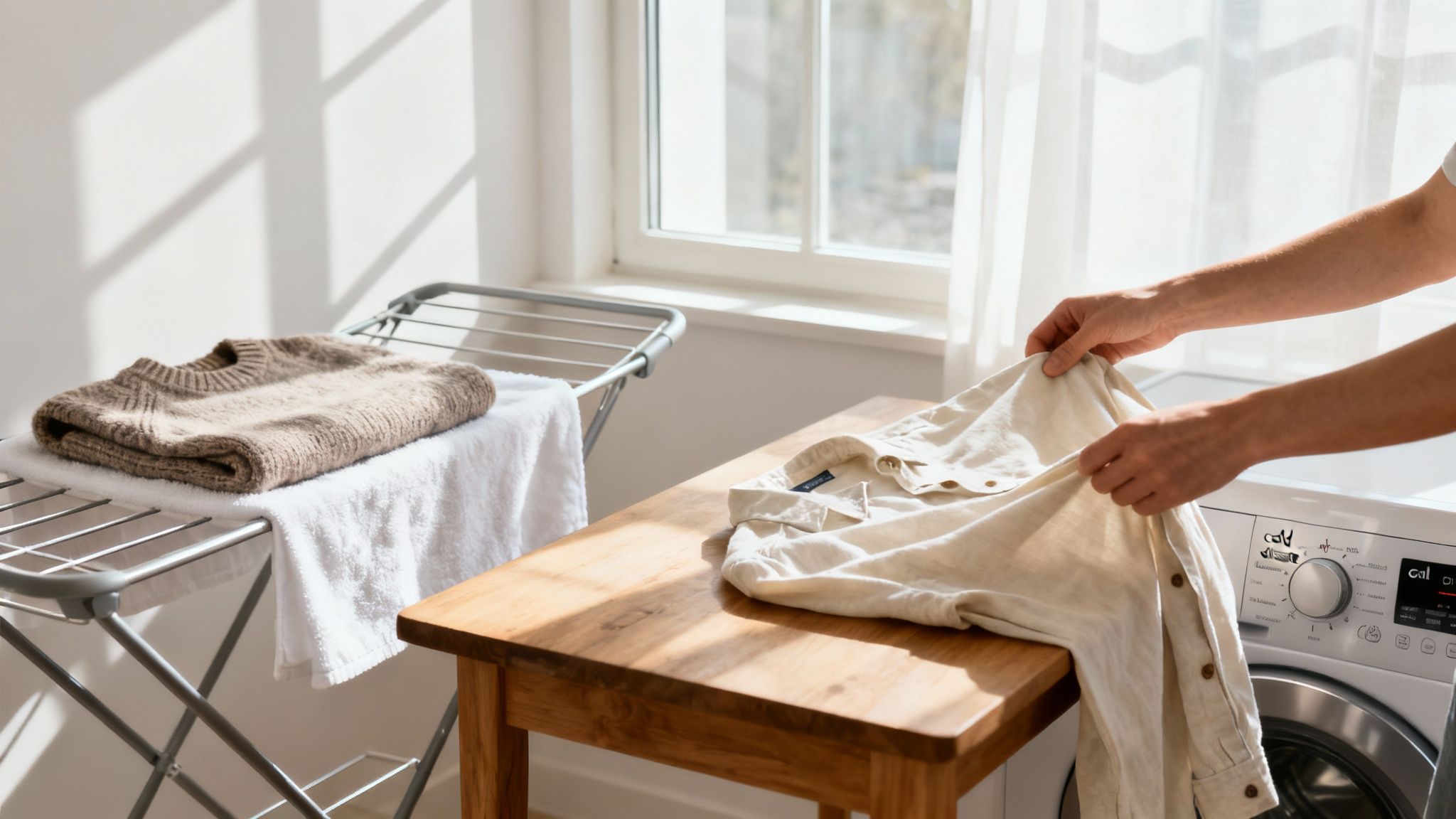
We’ve all been there. You pull your favorite sweater out of the dryer, only to find it’s mysteriously shrunk to a size that might fit a doll. It’s a truly frustrating moment. But what if I told you the solution is actually pretty simple? To keep your clothes from shrinking, you just need to avoid two things: heat and agitation.
Switching to cold water for washing and using low-heat or air-dry settings are the single most effective things you can do to protect your wardrobe.
Why Your Favorite Clothes Suddenly Don't Fit
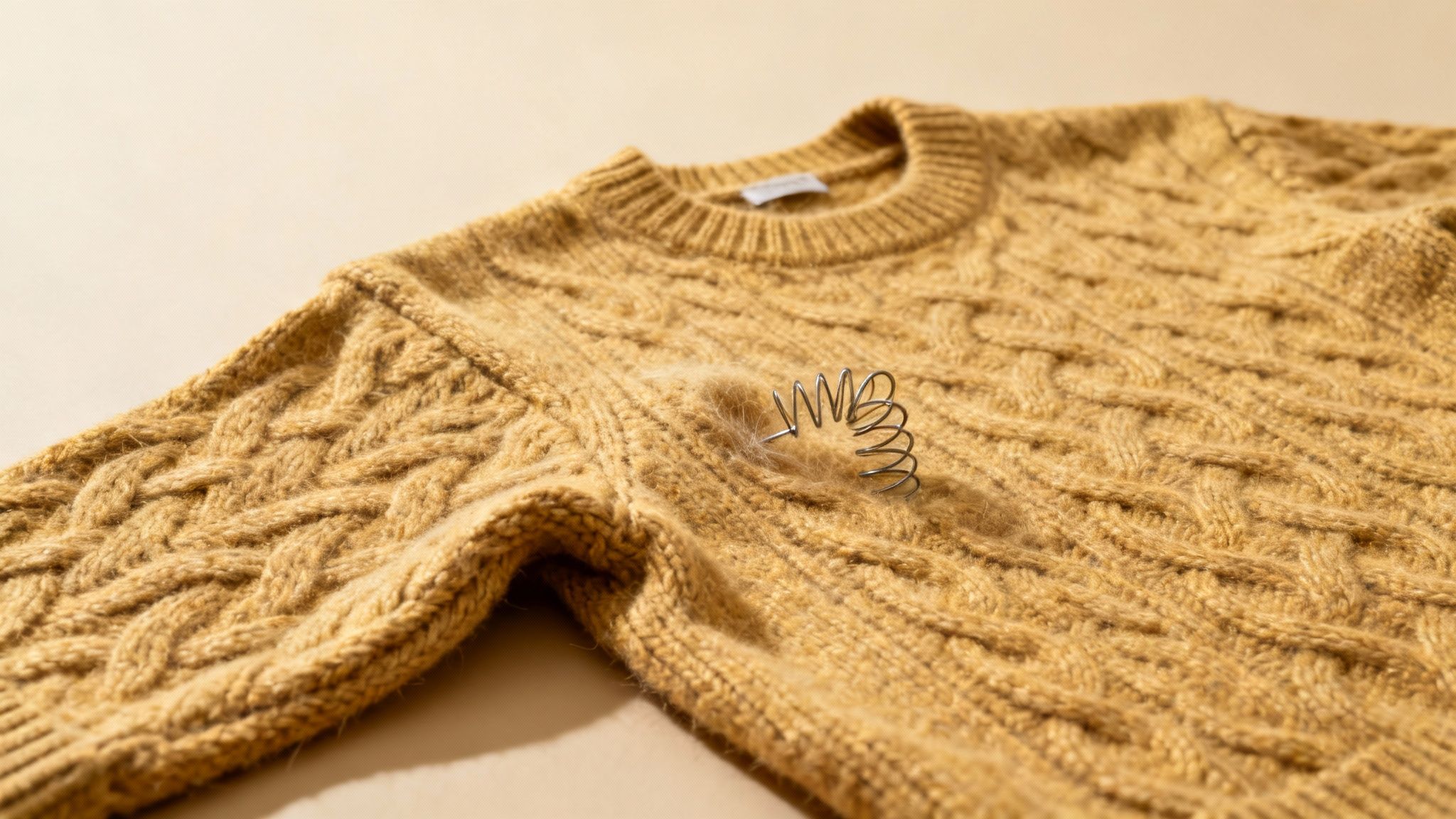
When your clothes shrink, it's not some laundry room curse—it's just science. The problem starts with the fabric fibers, particularly natural ones like cotton, wool, and linen. To create the clothes you buy, these fibers are stretched and held under tension during the manufacturing process.
When you toss those clothes into the heat, moisture, and tumbling action of your washer and dryer, all that tension gets released. The fibers relax and snap back to their shorter, more natural state. Think of it like a tightly wound spring that finally gets to uncoil.
The Main Culprits Behind Shrinking
Heat is, without a doubt, the number one offender. For cotton, washing in water above 40°C (104°F) dramatically increases the risk of shrinkage. And for something delicate like wool, any temperature over 30°C (86°F) can cause the fibers to felt and lock together for good, resulting in permanent, irreversible shrinkage.
But heat isn't the only thing working against you. Other factors play a big part in this frustrating laundry outcome:
- Excessive Agitation: Those rough, heavy-duty wash cycles physically beat up the fabric, encouraging the fibers to contract and tighten.
- Over-Drying: Even on a low heat setting, leaving clothes in the dryer for too long can continue to shrink the weave, making them tighter and smaller.
Understanding the science behind fabric wear and tear is the first step toward preserving your favorite garments. When you know why shrinking happens, you can take control of your laundry routine to prevent it.
By controlling these factors, you can create a much gentler environment for your clothes. It’s not about fighting a losing battle; it's about making mindful choices with your washer and dryer settings to help your clothes last.
Your Pre-Wash Ritual to Prevent Shrinking
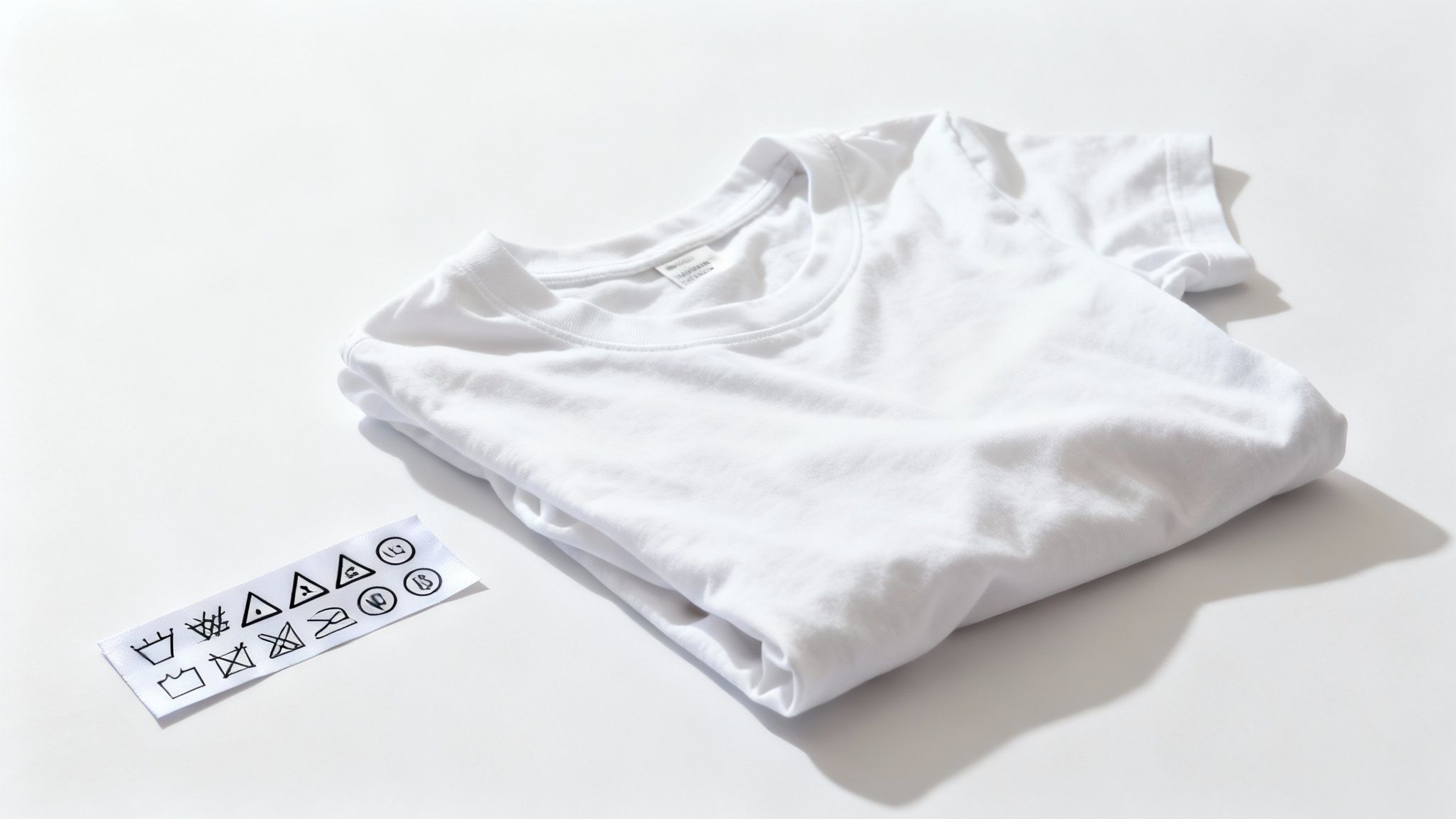
Believe it or not, the best way to stop your clothes from shrinking starts long before they ever get wet. Just a few minutes of prep work can make all the difference, saving your favorite shirt from a terrible, tiny fate. Think of this as your essential pre-laundry checklist for success.
First things first: you absolutely have to decode the care label. Those little symbols aren't just suggestions. They're the manufacturer's direct instructions for keeping that specific garment looking and fitting exactly as it should. Ignoring them is the quickest way to end up with a sweater fit for a doll.
Sort Smarter, Not Harder
Once you've peeked at the labels, it's time to get strategic with your sorting. Most of us just separate lights and darks, but to really prevent shrinking, you need to go a step further and sort by fabric type and weight.
Tossing a delicate cotton tee in with a load of heavy, abrasive bath towels is a recipe for disaster. All that friction from the heavier items stresses the fibers of your lighter clothes, encouraging them to tighten up and shrink.
Try this simple sorting system instead:
- Heavyweights: Group together things like denim, canvas, and those thick towels.
- Mediumweights: This is your everyday pile—think t-shirts, leggings, and most casual wear.
- Delicates: Anything like silk, linen, wool, or items with fine knits and lace needs its own separate, gentle cycle.
The goal here is pretty simple: create a low-friction environment inside your washing machine. When you wash similar fabrics together, you dramatically reduce the physical stress that leads to misshapen, shrunken clothes.
A Few Final Prep Steps
Before you hit "start," take a moment for a couple of final touches. It's a great habit to turn dark and brightly colored items inside out, especially your jeans and anything with a graphic print. This little move helps protect their color from fading and cuts down on that fuzzy pilling caused by friction.
Also, make sure you fasten all zippers, buttons, and hooks. An open zipper can easily snag a delicate knit during the wash, pulling and distorting the fabric's weave. These small habits take just seconds but add a huge layer of protection, making sure your clothes come out looking just as good as they did going in.
Choosing the Right Washer Settings Every Time
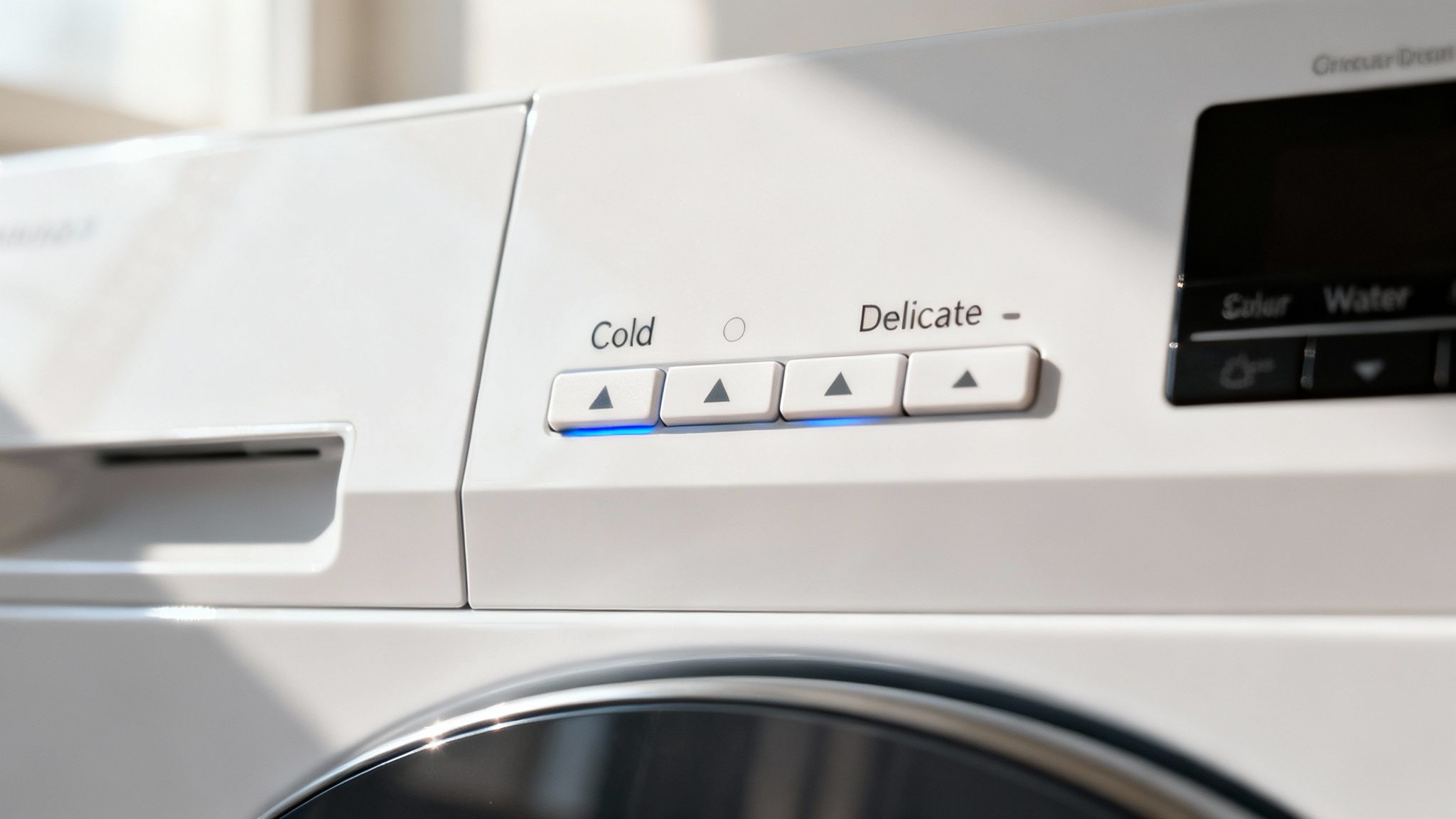
Think of your washing machine's control panel as the command center for preventing shrinkage. Getting it right isn't about memorizing complex rules—it’s about one simple principle: be gentle. Out of all the buttons and dials, the single most important choice you'll make is the water temperature.
Heat is the number one enemy of fabric stability. While it’s tempting to use hot water for a "deep clean," today's detergents are seriously effective even in cold water. Choosing a cold wash setting is your best defense, especially for natural fibers like cotton, wool, and linen that are notorious for shrinking. It gets your clothes perfectly clean without shocking the fibers into tightening up.
Selecting the Ideal Wash Cycle
Temperature is only half the battle. The cycle you choose determines how much physical stress your clothes go through, and a rough-and-tumble cycle can be just as damaging as high heat.
Make the ‘Delicate’ or ‘Hand Wash’ cycle your go-to for anything you're worried about. It’s not just for silk blouses anymore. This setting uses slower spins and less aggressive agitation, which is much kinder to the structure of your fabrics. It’s the perfect choice for keeping your favorite sweaters and t-shirts looking and fitting like new.
For a quick reference, here's a simple guide to matching your fabrics with the right wash settings.
Fabric Care Washing Guide
Following these simple guidelines can make a huge difference in how your clothes hold up over time.
Your washer settings are a powerful tool. The combination of cold water and a gentle cycle dramatically reduces the two main causes of shrinking: heat and mechanical stress. This simple adjustment is the secret to maintaining the original fit and feel of your garments.
So, when should you use the ‘Normal’ or ‘Heavy Duty’ cycles? Save those for truly tough, heavily soiled items that can take a beating—think work jeans, sturdy towels, or certain bed linens. Applying these same gentle principles is crucial for larger items, too. You can learn how to wash doonas without ruining them and protect even your bulkiest textiles from damage.
By making a conscious choice every time you do laundry, you take back control and ensure your clothes stay the size they're supposed to be.
The Art of Drying Clothes Without Disasters
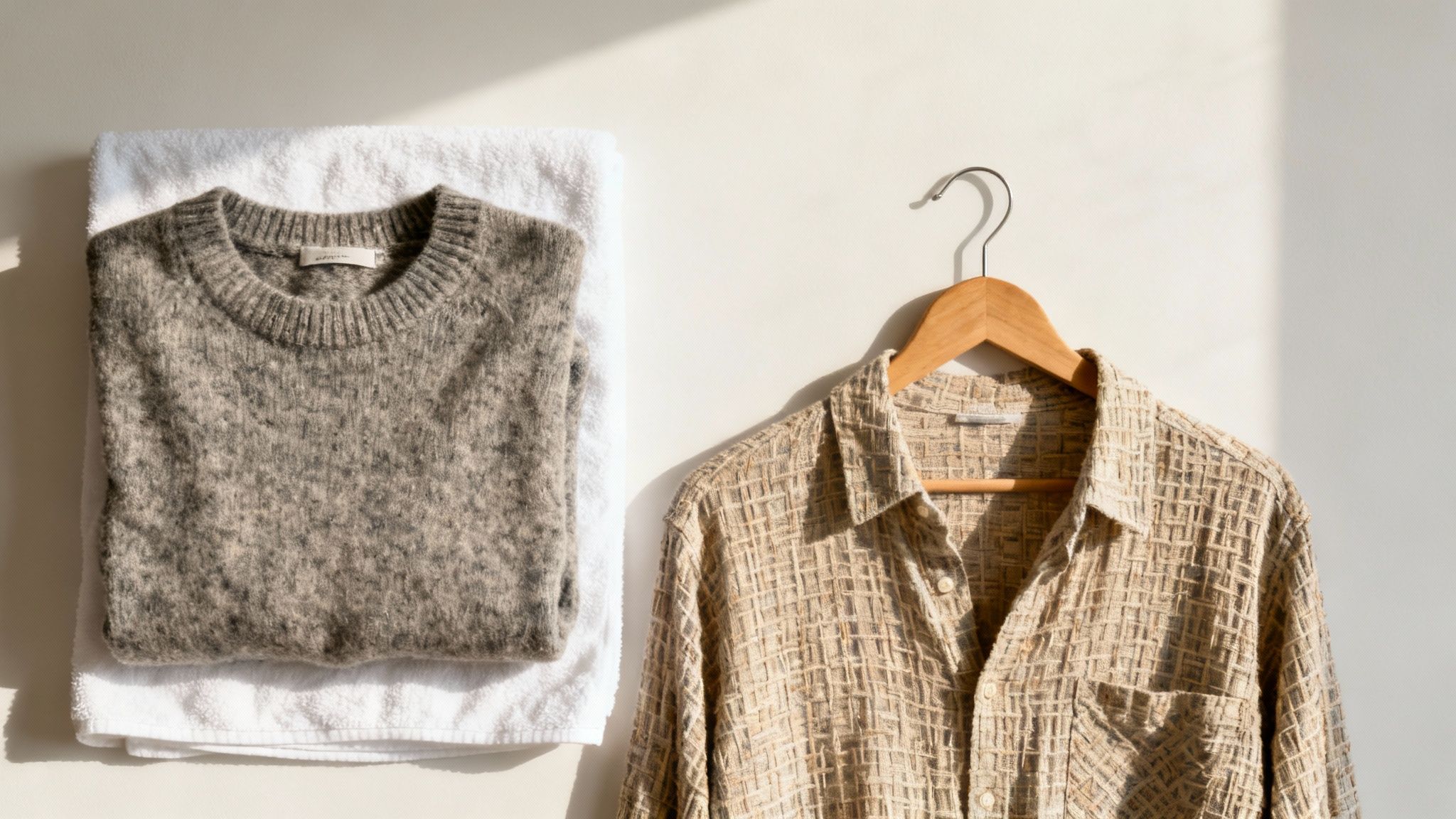
You’ve made it through the wash cycle unscathed, but don't celebrate just yet. The drying process is where most shrinkage tragedies really happen. That intense, focused heat from a machine dryer is public enemy number one for your clothes, causing the fabric fibers to contract at a rapid pace.
Honestly, the safest way to dry your clothes is to skip the machine entirely. Air-drying is your secret weapon in the war against shrinkage because it takes high heat completely out of the equation.
Master the Art of Air-Drying
Switching to air-drying is simpler than it sounds, and knowing a few key techniques can make all the difference. Not all garments are created equal, so how you air-dry them matters for keeping their original shape.
Take that chunky knit sweater you adore, for example. Never, ever hang it up. The weight of the water will pull it down, stretching it into a completely different garment. Instead, lay it flat on a clean, dry towel and gently pat it back into its proper shape. On the other hand, more structured pieces like woven shirts or blouses do best on a sturdy hanger, which helps preserve the shoulders and drape. For more ideas, check out our guide on how to air dry clothes indoors for setting up the perfect drying spot, no matter how much space you have.
By laying heavy knits flat and hanging lightweight wovens, you prevent both shrinking from heat and stretching from gravity. This preserves the original fit and structure of your favorite pieces.
Using Your Dryer The Smart Way
Let's be real, sometimes you just need the speed of a machine dryer. When that's the case, it's all about making smart choices to minimize the risk. High heat is never your friend here.
Always, always choose the lowest heat setting your dryer offers. Look for cycles like 'Tumble Dry Low' or even the no-heat 'Air Fluff' option. These settings gently toss your clothes with very little heat, which drastically lowers the odds of them shrinking.
Here's another pro-tip: pull your clothes out while they are still slightly damp. Over-drying is what really sucks all the moisture and life out of the fibers, causing them to shrink up. Let your clothes finish air-drying for that last 5-10% of the way. You can also toss in a few wool dryer balls. They bounce around, creating space between garments for better airflow, which can help speed up drying time and reduce their total exposure to heat.
A Practical Guide to Fabric Types and Shrink Risk
Before you can stop your clothes from shrinking, you have to know what you’re up against. Think of it this way: not all fabrics are created equal, and they each react to heat and water in wildly different ways. The first step is always checking the tag to understand what your clothes are actually made of.
Some materials are just naturally prone to shrinking. These are almost always natural fibers. Cotton is the most famous culprit, of course, but wool can be even worse. It undergoes a process called “felting,” where the fibers lock together and shrink for good. Delicate materials like linen and silk also don't play well with high heat, which can warp their shape and size in a single wash.
High-Risk vs. Low-Risk Materials
On the flip side, you’ve got the low-risk players: synthetic fibers. Materials like polyester, nylon, and acrylic are basically different forms of plastic. This molecular structure makes them incredibly stable and resistant to shrinking. You can usually wash and dry these with far less anxiety.
This is exactly why you see so many fabric blends on the shelves. That cotton/polyester t-shirt? It’s designed to give you the best of both worlds—the soft feel of cotton with the durable, shrink-resistant nature of polyester. Just remember, the higher the percentage of natural fibers, the more careful you need to be.
Shrinkage rates for clothes vary widely depending on fabric type and treatment. Historical data reveals that untreated wool can shrink by as much as 30% of its original size after repeated washing. In contrast, pre-shrunk or mercerized cotton commonly shrinks around 2-5%, demonstrating the effectiveness of textile finishing. Discover more insights about the global apparel market.
Making Smart Choices
This isn't just about laundry day; it’s about becoming a smarter shopper. A quick glance at the care tag before you buy can save you a ton of frustration down the line. If you want a fantastic overview on making clothes last and preventing common issues like shrinking, this comprehensive fabric care guide is a great resource.
Knowing your fabrics is also key to how you'll care for modern textiles and keep your high-tech fabrics looking new. Once you understand the material, you can predict how it’s going to behave and tweak your routine, making sure your clothes fit just right for years to come.
Common Questions About Shrinking Clothes
Even when you're super careful with your laundry, questions are bound to pop up. Let's tackle some of the most common dilemmas people face when trying to figure out how to stop their clothes from shrinking. With these answers, you can handle just about any laundry situation with total confidence.
Can I Actually Unshrink Clothes That Are Already Too Small?
It happens to the best of us, but don't toss that favorite sweater just yet! For natural fibers like cotton, wool, or cashmere, you can often relax the fibers and stretch them back out.
One of the most popular tricks is to soak the shrunken item for about 30 minutes in lukewarm water mixed with a capful of hair conditioner or baby shampoo. After it’s had a good soak, gently squeeze the water out—seriously, don't wring it—and lay it flat on a towel. From there, you can carefully stretch it back to its original size and shape.
Does "Pre-Shrunk" Mean It's Shrink-Proof?
Not exactly. While "pre-shrunk" means the fabric was washed and dried during the manufacturing process to get most of the shrinking out of the way, it’s not a 100% guarantee. A "pre-shrunk" t-shirt can still shrink another 2-5% if you throw it in a hot wash or blast it on high heat in the dryer. It's always best to treat these items with the same care you'd give any other delicate garment.
Taking that extra step matters more than you might think. Improper laundry habits are a huge contributor to textile waste. Globally, an estimated 10-15% of clothes are thrown out simply because of shrinkage and other fit issues, which is a big part of the 92 million tonnes of textile waste generated each year. You can dive deeper into these fast fashion statistics to see the full picture.
The bottom line is simple: cold water and low heat are your best friends, even for fabrics labeled "pre-shrunk." A little extra care ensures your clothes maintain their fit for much longer.
By keeping these details in mind, you can dramatically extend the life of your favorite clothes, making sure they look and feel great, wash after wash.
Tired of laundry day? At Columbia Pike Laundry, we offer professional wash & fold and dry cleaning services with convenient pickup and delivery. We give you back your time and peace of mind. Schedule your first pickup today!
Popular Blog Articles

Meet the Author
Daniel Logan didn’t start CPL because he loved laundry. He started it because his family was drowning in time debt, and laundry was one of the biggest weights.
Mornings were chaos with two kids under 5. Evenings felt like catch-up. And weekends? Gone to sorting socks and folding piles.
He knew his story wasn’t unique. So he built a business that gave families like his just a little bit of breathing room one load at a time.
With no laundry experience but deep tech skills, Daniel rolled up his sleeves, doing every job himself while building systems that turned it into a modern laundry service that saves customers time, simplifies their lives, and delivers reliability they can count on.
That’s where CPL began. Not from a playbook, but from pain. From one dad trying to buy back time: for himself, and for every household like his.



